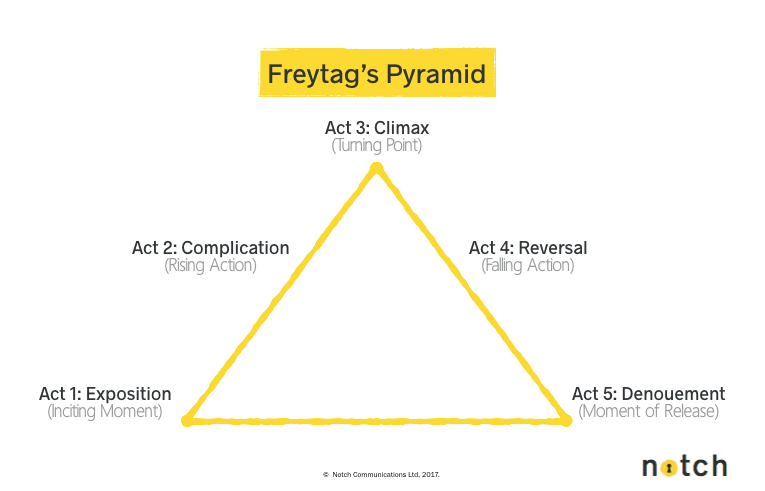It dates back to Aristotle and was often used by Shakespeare. (Talk about some serious name dropping, huh?) Freytag’s Pyramid is a structure of 5 movements, or acts, that make up a fully developed story. Whether it’s found in a play, a novel, a movie, or a presentation, this basic story structure is loved by humans everywhere. Today, we’ll break down how it works and provide a few ways you can use it in your next presentation.

Act 1: Exposition
Also called the inciting moment, the first movement in Freytag’s Pyramid gets the action started. This act introduces characters, provides context, explores the setting, and sets the mood. All of these things have one important goal in common, they invite the reader in. Toward the end of the first act, something usually happens that propels the story forward, creating momentum.
Act 2: Complication
In the second movement, tension rises as characters encounter obstacles. This growing conflict keeps the audience invested in the movement of the story. There’s a reason Aristotle formed the narrative plot in the shape of a triangle in his book Poetics. At this point in the story, it should feel like an uphill battle.
Act 3: Climax
Here, we’ve reached the turning point in the story. Things either start to get better and move toward resolution, or they get much, much worse. Look again to the pyramid structure; this point in the story should leave the audience feeling a bit precarious which serves to keep them engaged.
Act 4: Reversal
In the fourth movement, falling action occurs. This can be the most difficult stage to understand because it’s not quite conflict and it’s not quite resolution. It’s somewhere in the murky middle. Often an element of surprise is used so that the final outcome is not blatantly obvious. It’s important not to resolve the story fully yet.
Act 5: Denouement
While it is often called the resolution, I like the wording in the graphic above. “Moment of release” helps us to understand that “the conclusion makes way for the catharsis – an event or events allowing the tension or anxiety to loosen.” Because our brains have mirror neurons which allow us to experience a story as if we were actually living it out, it’s important that the story is fully resolved. That allows the audience member to release any tension that has built during the story.
How Can You Use It?
Get creative in the way you use stories in your presentations. They don’t have to be used in the same place or in the same way every time. You can even divide a story up and tell it in pieces throughout the presentation. Here are a few ideas of how to use it:
- Try opening your presentation with a brief story that follows this structure.
- Divide the conflict from the resolution to create suspense. Start with Acts 1 & 2 in the introduction, then move into information and data that fall outside of the direct story plot. Then, come back to Acts 3, 4, & 5 at a later part of your speech.
- Use a 5-act story to break up sections of dense data or information that is tough to process.
- End your presentation with a story to stir emotions and impact your audience.
When you use this story structure, you are following in a nearly timeless tradition, tracing the footsteps of the great storytellers and communicators. Make it yours, make it modern, but build on and trust the pattern of the great Freytag Pyramid.
Ethos3 is committed to helping you tell your story with clear content and stunning visuals. Get in touch with our team today.